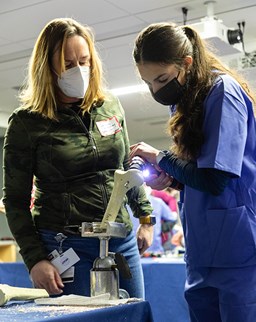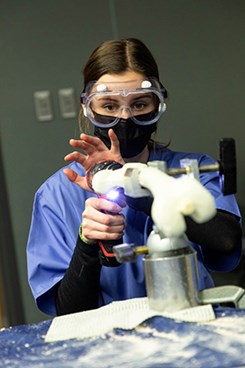Breaking Ortho's Gender Barrier, with Power Tools and Mentorship
 Only seven percent of attending orthopaedic surgeons in the U.S. are women, but female faculty in UR’s Department of Orthopaedics have long been part of a nationwide effort to turn those numbers around.
Only seven percent of attending orthopaedic surgeons in the U.S. are women, but female faculty in UR’s Department of Orthopaedics have long been part of a nationwide effort to turn those numbers around.
For the past decade, the department has hosted The Perry Initiative–an immersive learning experience for female high school and college students aimed at inspiring more young women to pursue orthopaedics or bioengineering careers.
Named for one of the nation’s first female orthopaedic surgeons, Jacquelin Perry, the program partners female orthopaedic surgeons with young women who sign up for learning events held around the country. It’s offered annually at UR; COVID interrupted the event for the past two years but in-person sessions resumed March 4 and 5 at the Medical Center.
The March 4 session was open to University of Rochester students; the following day, approximately 30 girls from Rochester and suburban high schools gathered for a day-long workshop in the Center for Experiential Learning. Department of Orthopaedics faculty who volunteered as instructors were Judy Baumhauer, M.D., M.P.H.; Emily Carmody, M.D.; Catherine Humphrey, M.D.; Stephanie Siegrist, M.D.; Danielle Wilbur, M.D.; and Jeanne Delsignore, M.D., a retired private practice hand surgeon who was the first female orthopaedic surgery attending physician in Rochester.
For high school students, the Perry session included lectures by orthopaedic surgeons and engineers, hands-on practice in orthopaedic skills, and a Q-and-A session and discussion (with parents in tow) to cap off the day. Participants practiced casting, suturing, and bone and joint repairs, using artificial bones and joints, as well as real-life chicken thighs and pig skin for the suturing.
At a Perry session, the learning and the fun can get pretty loud: participants wield the same tools their surgeon-instructors do in the OR–power saws and drills, maybe a hammer here and there–while they try their hand at skills they may do professionally one day.
For many of these young women, it’s the first time they’ve ever had a power tool in their hands. But the new experiences don’t stop there. It may also be their first meeting with female orthopaedic surgeons–and certainly the first time they’ve had the opportunity to spend the day with a group of them to hear about their experiences pursuing a career in orthopaedics, the least gender-inclusive of all surgical specialties.
The opportunity to learn from women who are helping to level the gender-imbalance in this profession–hearing them talk about the challenges they faced and overcame–can be as powerful for students as the hands-on practice and class instruction.
 When it comes to gender parity, Orthopaedics at UR is better than the national averages of 14 percent of residents and 7 percent attendings in practice. With 8 residents and 8 attendings, females represent 21 percent of the department’s residents and 19.5 percent of its attending orthopaedic surgeons. But here and around the country, there’s still a long way to go. In addition to The Perry Initiative, Orthopaedics also partners with Nth Dimensions, a national mentorship program founded by orthopaedic surgeons to address the low numbers of women and underrepresented minorities in the field of orthopaedic surgery.
When it comes to gender parity, Orthopaedics at UR is better than the national averages of 14 percent of residents and 7 percent attendings in practice. With 8 residents and 8 attendings, females represent 21 percent of the department’s residents and 19.5 percent of its attending orthopaedic surgeons. But here and around the country, there’s still a long way to go. In addition to The Perry Initiative, Orthopaedics also partners with Nth Dimensions, a national mentorship program founded by orthopaedic surgeons to address the low numbers of women and underrepresented minorities in the field of orthopaedic surgery.
More equal gender representation is essential because "we don’t just treat men as patients," Dr. Wilbur said. "It’s important for patients to have doctors who look like them, whether they are female or from underrepresented groups, so nobody is left behind."
Participants had a lot of questions for Dr. Wilbur and the other surgeons. The one that came up most often, Dr. Wilbur said, was, "'How did you get here?' When you’re in a male-dominated field, they see that and want to know what inspired us to pursue this career, and they ask, 'How can I get to those positions as well?'"
Luanys Rivera, a 16-year-old junior at East High School, came to the Perry session because, "I wanted to figure out what kind of medical career I want to pursue. I wanted to test myself, challenge myself, to see if maybe I want to be in orthopaedics. I wanted to answer the questions I’ve had on my mind."
For her, the event gave her valuable exposure to the field–and to female surgeons already practicing in it–to help her set a professional path before she gets to college. She and her classmates took power tools in hand to simulate ACL reconstruction, practice intermedullary nail fixation for a broken femur, and use plates and screws to repair a broken tibia, along with casting a fracture and suturing a wound. The experience gave her a lot to think about–and an opportunity to gain confidence for the professional paths ahead of her.
"I’m very surprised at myself," Rivera said. "I never expected that I could literally put two pieces of bone together and have that learning experience. It’s surprising to see myself doing that. It was actually quite fun, to have that learning experience and see what it’s really like."